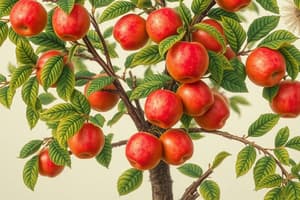Podcast
Questions and Answers
How do rootstocks contribute to fruit quality in grapevines?
How do rootstocks contribute to fruit quality in grapevines?
Rootstocks enhance color intensity, aroma complexity, acidity balance, and overall flavor profiles. They also help improve berry size and reduce herbaceous tastes.
Why is selecting appropriate rootstocks important for climate adaptation in viticulture?
Why is selecting appropriate rootstocks important for climate adaptation in viticulture?
Rootstocks need to be adapted to local temperatures and tolerant to changing precipitation patterns and water scarcity concerns to ensure successful cultivation.
How do rootstocks impact yield potential in grapevines?
How do rootstocks impact yield potential in grapevines?
Rootstocks can affect both quantity and quality of the yield. Some promote fast growth leading to higher volumes but potentially compromising fruit quality, while slower-growing rootstocks improve fruit concentrations.
Why is understanding the interplay between rootstocks and scions fundamental in grapevine propagation?
Why is understanding the interplay between rootstocks and scions fundamental in grapevine propagation?
What role do rootstocks play in disease resistance in grapevines?
What role do rootstocks play in disease resistance in grapevines?
Match the following rootstocks with their disease resistance:
Match the following rootstocks with their disease resistance:
Match the following pairs in disease resistance:
Match the following pairs in disease resistance:
Match the following challenges with rootstock utilization:
Match the following challenges with rootstock utilization:
Match the following statements with their implications for disease resistance:
Match the following statements with their implications for disease resistance:
Match the following concepts in disease resistance:
Match the following concepts in disease resistance:
Flashcards are hidden until you start studying
Study Notes
Rootstocks Shaping Scion Varieties' Success
When we talk about grapevines, it's often the scions—the plant parts carrying specific grape varieties’ genetic material—that capture our attention with their tantalizing names like Cabernet Sauvignon, Chardonnay, or Syrah. However, beneath these famous vines lies another crucial component influencing their success: rootstocks. This article will explore how rootstocks affect vine performance by enhancing disease resistance, shaping growth characteristics, improving fruit quality, increasing climate adaptability, and boosting yield potential.
Disease Resistance
Rootstocks play a vital role in protecting scions from soilborne diseases such as phylloxera, which decimated European vineyards during the late nineteenth century. By grafting resistant rootstocks onto susceptible scions, growers can shield their vines from devastating losses due to pests and pathogens. Moreover, some rootstocks offer protection against other soilborne diseases, including armillaria root rot and verticillium wilt.
Growth Characteristics
Rootstocks also impact the physical and developmental characteristics of the resulting plants. For instance, certain rootstocks promote vigorous growth patterns, allowing vines to produce heavier yields and achieve optimal maturity more quickly. In contrast, others encourage slower growing habits, leading to smaller crops of higher concentration flavors and acids. These variations cater to different production goals, whether they aim for high volume or premium wine production.
Fruit Quality
In addition to bolstering vine health and controlling vigor, rootstocks contribute significantly to fruit quality. Some rootstocks enhance color intensity, aroma complexity, acidity balance, and overall flavor profiles. Others help improve berry size and reduce herbaceous tastes, creating balanced, appealing wines. Consequently, when selecting rootstocks, winemakers must consider both vineyard management objectives and desired sensory qualities in their chosen grapes.
Climate Adaptation
Climatic conditions profoundly shape where and how grapevines thrive, making flexible rootstocks valuable assets in modern viticulture. Grape species native to cooler climates may underperform in warmer regions, requiring rootstocks adapted to local temperatures. Similarly, drought tolerance becomes increasingly important amid changing precipitation patterns and water scarcity concerns. Therefore, selecting appropriate rootstocks helps ensure successful cultivation regardless of regional weather fluctuations.
Yield Potential
Lastly, rootstocks have notable impacts on yield potential, affecting both quantity and quality. For example, rootstocks that promote fast growth may increase yield volumes; however, this rapid growth might compromise fruit quality. On the other hand, slower-growing rootstocks lead to lower crop quantities yet improved fruit concentrations. Ultimately, rootstock selection requires balancing desirable attributes, ensuring sustainable, economical, and qualitative outcomes.
As you delve deeper into grapevine propagation techniques and plant breeding strategies, remember that understanding the interplay between rootstocks and scions is fundamental to developing robust, productive, and delicious grapevines. Thanks to extensive research, a broad spectrum of rootstocks tailored for various needs now exists, enabling us to optimize viticultural practices across global wine regions.
Studying That Suits You
Use AI to generate personalized quizzes and flashcards to suit your learning preferences.

